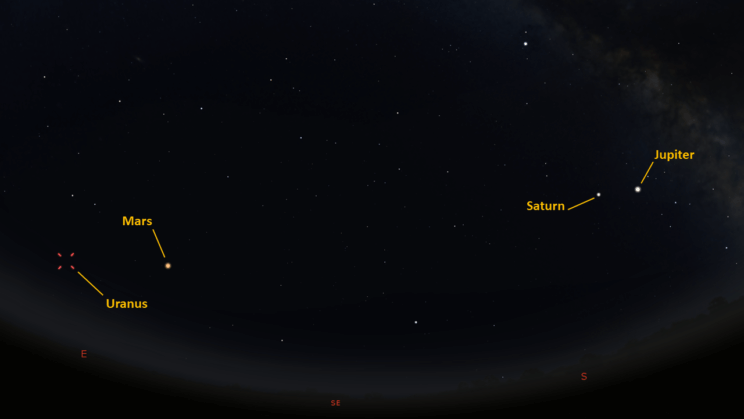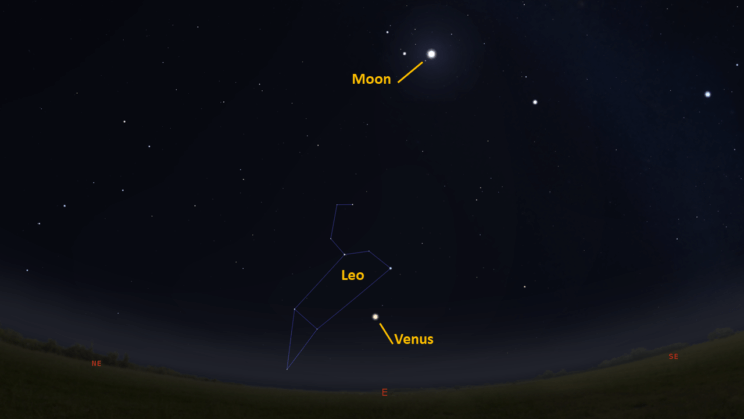This is the Saint Louis Science Center’s NIGHT SKY UPDATE for the week of Friday, October 9, 2020.
Information updated weekly or as needed.
Times given as local St. Louis time (CDT). For definitions of terminology used in the night sky update, click the highlighted text.
Public Telescope Viewings
Star parties at the Saint Louis Science Center have temporarily been canceled due to recommendations from the CDC regarding COVID-19. All public telescope events are canceled until further notice. As conditions change, we will reevaluate and update this article once public observing events resume.
Observing Highlight of the Week
This week we will look at a good starting point for those just beginning to learn the sky. Often it is said that constellations are the place to begin. I tend to agree with this, but they are not as easy to find as we may make it seem. One of the great frustrations is constellations rarely appear as they are named. This week we will offer four simple patterns that are easy to see in light pollution and they help identify the seasonal skies.
The four patterns we will cover can be called seasonal asterisms. An asterism is a recognized pattern of stars that is not part of the official 88 constellations. The most famous of these unofficial patterns is the Big Dipper. Each season has a shape that is easy to recognize as they are basic geometric shapes. These seasonal asterisms are the Great Square of Autumn, the Winter Circle, the Spring Diamond and the Summer Triangle. It is important to note that they are not only visible during the seasons they are name for but rather they are best seen at those times. During their seasons, these asterisms will be found rising in the east after sunset.
The Great square of Autumn is comprised of the four bright stars Alpheratz, Scheat, Markab and Algenib. The first of these is part of the constellation Andromeda and the remaining three are part of Pegasus.
The Winter Circle is the largest of the seasonal asterisms being made up of seven stars. They are Sirius in the constellation Canis Major, Procyon in Canis Minor, Pollux and Castor in Gemini, Capella in Auriga, Aldebaran in Taurus, and Rigel in Orion. Some might call this asterism the Winter Hexagon as the circle created when you connect the dots is more egg-shaped.
The Spring Diamond is comprised of the stars Denebola in the constellation Leo, Spica in Virgo, Arcturus in Bootes and Cor Caroli in Canes Venatici. Unfortunately, the Spring Diamond is a pattern we will not fully see this time of the year.
The Summer Triangle is made with the stars Deneb, Vega and Altair. Deneb is in the constellation Cygnus, Vega is in Lyra and Altair is in Aquila.
Around 8:00 p.m. this week you will find the Great Square high in the east, the Summer triangle high in the west and the eastern edge of the Spring Diamond setting in the west. The Winter circle will be in the east by 2:00 a.m. Starting with these four simple shapes is a great way to learn the sky.
The Sun and Moon

The Moon as seen from the International Space Station, on July 31, 2011.
Credit: NASA
Sunrise is at 7:05 a.m. on Friday, October 9 and sunset is at 6:30 p.m. providing us with about 11.4 hours of daylight. Even after sunset, the light from the Sun will dimly illuminate our sky for about 1 hour and 30 minutes. This period is called twilight, which ends around 7:59 p.m. this week. For those with a sundial, local noon occurs around 12:48 p.m. this week.
| Day | Sunrise | Sunset |
|---|---|---|
| 2020-10-09 | 7:05 a.m. | 6:30 p.m. |
| 2020-10-10 | 7:06 a.m. | 6:29 p.m. |
| 2020-10-11 | 7:07 a.m. | 6:28 p.m. |
| 2020-10-12 | 7:08 a.m. | 6:26 p.m. |
| 2020-10-13 | 7:09 a.m. | 6:25 p.m. |
| 2020-10-14 | 7:10 a.m. | 6:23 p.m. |
| 2020-10-15 | 7:11 a.m. | 6:22 p.m. |
| 2020-10-16 | 7:12 a.m. | 6:20 p.m. |
| 2020-10-17 | 7:13 a.m. | 6:19 p.m. |
Moon
Moonrise for Friday, October 9 occurs at 11:45 p.m. and moonset will occur at 3:03 p.m. on the following day. On Friday, October 9 the Moon will exhibit a waning gibbous phase with about 55% of the lunar disk illuminated. Last quarter moon occurs on October 9 at 7:40 p.m.
International Space Station (ISS) Observing

Visible passes of ISS from St. Louis for the week of October 9 occur during evening hours. The only pass this week occurs on October 11. Use the table below for information about this visible pass. ISS will return to St. Louis skies on the morning of October 21.
Catch ISS from St. Louis starting Friday, October 9
| Date | Starts | Max. altitude | Ends | |||||||
|---|---|---|---|---|---|---|---|---|---|---|
| Time | Alt. | Az. | Time | Alt. | Az. | Time | Alt. | Az. | ||
| 11 Oct | -0.8 | 18:51:08 | 10 | W | 18:53:22 | 17 | SW | 18:55:35 | 10 | S |
Magnitude (Mag): The Measure of brightness for a celestial object. The lower the value is, the brighter the object will be.
Altitude (Alt): The angle of a celestial object measured upwards from the observer’s horizon.
Azimuth (Az): The direction of a celestial object, measured clockwise from an observer’s location with north being 0°, east being 90°, south being 180° and west being 270°.
For information about ISS flyovers and other visible satellites, visit www.heavens-above.com
Detailed information regarding all unmanned exploration of our universe, missions past, present, and planned, can be found at Jet Propulsion Laboratories:
The Visible Planets

Looking Southeast, at 8:30 pm, October 9, 2020
Credit: Stellarium, EG

Looking East, 5:00 am, October 10, 2020
Credit: Stellarium, EG
This week, four naked eye planets are visible. Jupiter and Saturn rise before sunset. Look for them in the south once it is dark. Mars rises around sunset and will be best seen at midnight. Venus can be found in the eastern sky before sunrise.
For those tracking Jupiter and Saturn as they approach their great conjunction later this year, the two gas giants currently appear about 6.68° apart in the sky. From now until December 21, Jupiter will appear closer to Saturn each night.
Venus
Venus is well into another morning apparition. After months of seeing Venus in the west after sunset Venus is now visible in the east before sunrise. Venus rises at 3:56 a.m. and will be easily seen by 5:00 a.m. Venus remains a morning object until March 26, 2021 when it reaches superior conjunction. Since Venus has passed greatest western elongation, it will start to exhibit a gibbous phase.
Mars
Opposition for Mars occurs on October 13, 2020. As we head towards this date Mars will appear brighter and larger through a telescope improving surface details. Surface features are already visible when viewing conditions are favorable. Current apparent brightness of Mars is -2.6 magnitude. At this magnitude Mars appears brighter than Jupiter. Look for Mars rising around the time of sunset.
Jupiter
Look for Jupiter in the south about 30 minutes after sunset. Jupiter will set at 11:45 p.m. Those with a telescope can enjoy views of Jupiter’s cloud features and the Great Red Spot when it is pointed towards Earth.
Saturn
Look for the ringed planet in the south about 30 minutes after sunset. Saturn sets at 12:23 a.m. For those with a telescope keep track of the orientation of Saturn’s rings. Since Saturn is tilted on its rotational axis, we cross the plane of Saturn’s ring every 13 to 15 years. We are headed towards another ring plane crossing on March 23, 2025. Over the next five years you will notice Saturn’s rings will gradually incline towards an edge on appearance.
Uranus
Uranus is not a planet we normally include in this section. Even at its dimmest, the giant planet does hover within naked eye visibility. That said, it is so close to the visible limit of the human eye it just is not reality for most of us to hope to see Uranus without the aid of binoculars or a telescope. Uranus will rise around 7:22 p.m.
Like other planets, when at opposition, Uranus will appear brighter than it normally does. As we approach opposition with Uranus it will shift from a visual magnitude of 5.9 to 5.7. That extra bump in magnitude makes all the difference as it is now easy to see in binoculars. The current magnitude for Uranus is 5.7. Uranus will reach opposition on October 31, so grab those binoculars and try to spot the 3rd largest planet in our solar system. You can find a finder chart for Uranus here
2020 Great Conjunction
This year the planets Jupiter and Saturn will reach conjunction. A conjunction is when two or more celestial bodies share the same right ascension. For Jupiter and Saturn this astronomical event occurs every 20 years. The conjunction occurs on December 21, 2020. You will find the two planets close together in the southwest just after sunset on this date.
Visit the James S. McDonnell Planetarium for more information on what’s up!
Night Sky Update: October 9-October 17, 2020






